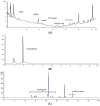Carotenoids, Phenolic Compounds and Tocopherols Contribute to the Antioxidative Properties of Some Microalgae Species Grown on Industrial Wastewater
- PMID: 26690454
- PMCID: PMC4699242
- DOI: 10.3390/md13127069
Carotenoids, Phenolic Compounds and Tocopherols Contribute to the Antioxidative Properties of Some Microalgae Species Grown on Industrial Wastewater
Abstract
This study aimed at investigating the potential of microalgae species grown on industrial waste water as a new source of natural antioxidants. Six microalgae from different classes, including Phaeodactylum sp. (Bacillariophyceae), Nannochloropsis sp. (Eustigmatophyceae), Chlorella sp., Dunaniella sp., and Desmodesmus sp. (Chlorophyta), were screened for their antioxidant properties using different in vitro assays. Natural antioxidants, including pigments, phenolics, and tocopherols, were measured in methanolic extracts of microalgae biomass. Highest and lowest concentrations of pigments, phenolic compounds, and tocopherols were found in Desmodesmus sp. and Phaeodactylum tricornuotom microalgae species, respectively. The results of each assay were correlated to the content of natural antioxidants in microalgae biomass. Phenolic compounds were found as major contributors to the antioxidant activity in all antioxidant tests while carotenoids were found to contribute to the 1,1-diphenyl-2-picryl-hydrazil (DPPH) radical scavenging activity, ferrous reduction power (FRAP), and ABTS-radical scavenging capacity activity. Desmodesmus sp. biomass represented a potentially rich source of natural antioxidants, such as carotenoids (lutein), tocopherols, and phenolic compounds when cultivated on industrial waste water as the main nutrient source.
Keywords: DPPH; FRAP; antioxidants; carotenoids; microalgae; phenolic compounds; tocopherols; wastewater.
Figures



References
-
- Li H.B., Cheng K.W., Wong C.C. Evaluation of antioxidant capacity and total phenolic content of different fractions of selected microalgae. Food Chem. 2007;102:771–776. doi: 10.1016/j.foodchem.2006.06.022. - DOI
Publication types
MeSH terms
Substances
LinkOut - more resources
Full Text Sources
Other Literature Sources
Medical
Miscellaneous

